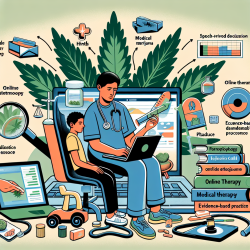Introduction
The growing interest in medical marijuana as a treatment option for various medical and psychiatric disorders has sparked considerable debate and research. The narrative review titled "Narrative review of the safety and efficacy of marijuana for the treatment of commonly state-approved medical and psychiatric disorders" provides a comprehensive overview of the existing literature on this topic. As practitioners, it is crucial to base our decisions on data and evidence, particularly when it comes to the well-being of children. This blog aims to distill the findings of the review and encourage further research and data-driven practice.
Key Findings from the Review
The review highlights several medical conditions for which marijuana is commonly approved at the state level, including Alzheimer's disease, amyotrophic lateral sclerosis (ALS), cancer, Crohn's disease, epilepsy, glaucoma, hepatitis C, HIV/AIDS, multiple sclerosis, chronic pain, severe nausea, and post-traumatic stress disorder (PTSD). Despite its approval, the review finds insufficient evidence to support the widespread recommendation of marijuana for these conditions.
For many of these disorders, the evidence is either mixed or lacking in rigor. For instance, while there is some support for the use of cannabinoids in managing symptoms of cachexia and severe nausea, the evidence for its efficacy in treating conditions like Alzheimer's disease and epilepsy is limited. The review emphasizes the need for randomized controlled trials (RCTs) with larger sample sizes to better understand the potential benefits and risks associated with marijuana use.
Implications for Practitioners
As practitioners, particularly those working with children, it is imperative to approach the use of medical marijuana with caution. The review underscores the importance of conducting well-designed studies to ascertain the safety and efficacy of marijuana compared to existing pharmacological treatments. This is particularly crucial in pediatric populations, where the long-term effects of marijuana use are not well understood.
Practitioners are encouraged to stay informed about the latest research and to critically evaluate the evidence before considering marijuana as a treatment option. Collaboration with researchers and participation in clinical trials can also help advance our understanding of marijuana's role in treating various disorders.
Encouraging Further Research
The review highlights several areas where further research is needed, including the effects of isolated cannabinoids, the impact of different strains of marijuana, and the development of objective measures for assessing treatment outcomes. Practitioners can play a vital role in advocating for and participating in research efforts that seek to address these gaps in knowledge.
By contributing to the body of evidence, practitioners can help ensure that treatment decisions are based on robust data, ultimately leading to better outcomes for patients, especially children.
Conclusion
While the potential of medical marijuana as a treatment option is intriguing, the current evidence does not support its widespread use for medical and psychiatric disorders. As practitioners, we must remain committed to data-driven decisions and prioritize the safety and well-being of our patients. Continued research and collaboration are essential to unlocking the full potential of marijuana as a therapeutic agent.
To read the original research paper, please follow this link: Narrative review of the safety and efficacy of marijuana for the treatment of commonly state-approved medical and psychiatric disorders.










